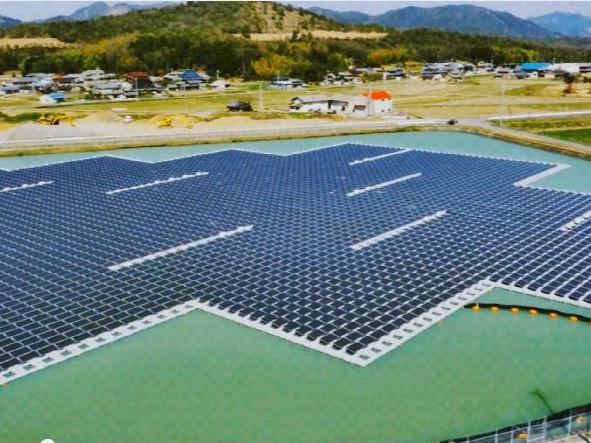






2. Pellets 8mm
3. 6-8 mm DIN+ Quality Pellets
4. We manufacture and sell fuel pellets from straw to European countries
5. Sell wood pellets
6. Wood pellet manufacturing
7. Sunflower Husk Pellets
8. Din Plus Wood Pellets
9. Export of sunflower husk pellets to the European market
10. Export of sunflower husk pellets to the European market
Floating solar panels generating green energy
Mon-23-2016
In two years, if construction goes as planned, 50,904 panels will float atop the reservoir, generating enough electricity to power almost 5,000 homes, according to Kyocera, the company building the solar plant.
The project, once completed, will be the largest installation of its kind in the world. But floating solar arrays are becoming more popular, with installations already operating in Australia and the United States, and more planned or under construction.
The growing interest is driven in part by huge growth in the solar market in recent years, as the cost of the technology has dropped quickly.
Solar panels on water - new profitable decision
Floating solar arrays — they are often referred to as “floatovoltaics,” a term trademarked by one company — also have advantages over solar plants on land, their proponents say. Renting or buying land is more expensive, and there are fewer regulations for structures built on reservoirs, water treatment ponds and other bodies of water not used for recreation.
Unlike most land-based solar plants, floating arrays can also be hidden from public view, a factor in the nonprofit Sonoma Clean Power Company’s decision to pursue the technology.
“Sonoma County boasts some of the most beautiful rolling hills, and people don’t want to see them covered by solar panels,” said Rebecca Simonson, a senior power analyst for the renewable energy developer, which has signed purchasing agreements for floating solar arrays to be built on six treated water ponds in the county. The solar panels, she said, would not be visible from the road.
The floating arrays have other assets. They help keep water from evaporating, making the technology attractive in drought-plagued areas, and restrict algae blooms. And they are more efficient than land-based panels, because water cools the panels.
“The efficiencies are what motivated us to look at this,” said Rajesh Nellore, chief executive officer of Infratech Industries, which has completed the first section of a floating solar plant in Jamestown, Australia, that will eventually cover five water treatment basins. The installation, which went into operation last year, generates up to 57 percent more energy than a rooftop solar plant.
Every week, we'll bring you stories that capture the wonders of the human body, nature and the cosmos.
At the Jamestown plant, the panels are specially coated to prevent corrosion, and set on a tracking system that moves them to maximize sunlight during the course of a day. The finished system will generate four megawatts of electricity, or enough to power 3,000 to 3,500 homes. The company is working on a similar project in Holtville, a small city in Southern California, which has suffered from years of drought.
Mr. Nellore notes that each floating solar project comes with its own engineering challenges. Floating panels, for example, can face stiffer winds than land-based arrays. But he said the biggest obstacle he faced was convincing government water agencies that the floating technology served their interests.
“It’s limited by what incentives there are and what the government wants,” Mr. Nellore said.
He noted that in Los Angeles, the Water Department covered a reservoir with $34.5 million worth of black plastic balls to slow evaporation; floating solar panels might have served the same purpose and also generated energy.
Kyocera, for its part, turned to floating panels because solar power has become so popular in Japan that big tracts of land for typical panel setups are hard to come by, said a spokeswoman, Natsuki Doi. She added that construction time and labor for a floating array was far less than for a land-based installation.
Floating solar panels are trendy all over the world
The Far Niente winery in Oakville, Calif., was an early adopter of floating solar panels, placing 994 of them on pontoons over an irrigation pond at the winery in 2008. Greg Allen, a winemaker at Far Niente who is a mechanical engineer by training, said the company was interested in solar power and wanted to find a way to eliminate 100 percent of their energy costs.
Utility rebates and tax credits helped defray some of the $4.2 million cost for the floating array, which took two and a half years to design and build, and another 1,302 solar panels installed on land. The system is expected to pay for itself by 2020 or sooner, Mr. Allen said.
The 3-foot by 5-foot solar panels on the pond are mounted on 130 foam-filled plastic pontoons made from drainpipes.
“We were nervous about a lot of things when we got into the project,” Mr. Allen said. But putting the panels on water saved vineyard space, and the floating system, combined with a solar array on land, generates up to 477 kilowatts of electricity at peak production.
At least one other winery has followed suit, and Mr. Allen said Far Niente has received visitors from India, China, Singapore and New South Wales who are interested in the technology.
Inhabitants of the pond seem unperturbed, he added.
“The fish are happy, the frogs are happy, the ducks came back,” he said. “It’s a very healthy pond.”
Source: http://ukrfuel.com/news-new-solar-plants-generate-floating-green-79.html
Any copying and distributing withoutactive hyperlink is strictly prohibited!
Views: 1369
 Stobart biomass division is to make a deal
Stobart biomass division is to make a deal
Biomass Related News
- The world's most efficient solar panel
- The multipurpose bioenergy plant in Skelleftea, Sweden
- Helping businesses and organisations
- Solar power battery charging becomes reality
- Wheatfield government provides solar panel moratorium
- Providing renewal security to Drax Power Station
- Drax is criticised over use of subsidies for coal and wood-burning power station
- Burning wood biomass: an opportunity or a problem?
- Growing bioproducts workforce
- In Ukraine the number of solid fuel (wood pellets) producers in 2011 - 2012 doubled
|
© Ukrainian Biofuel Suppliers 2008-2024 |
